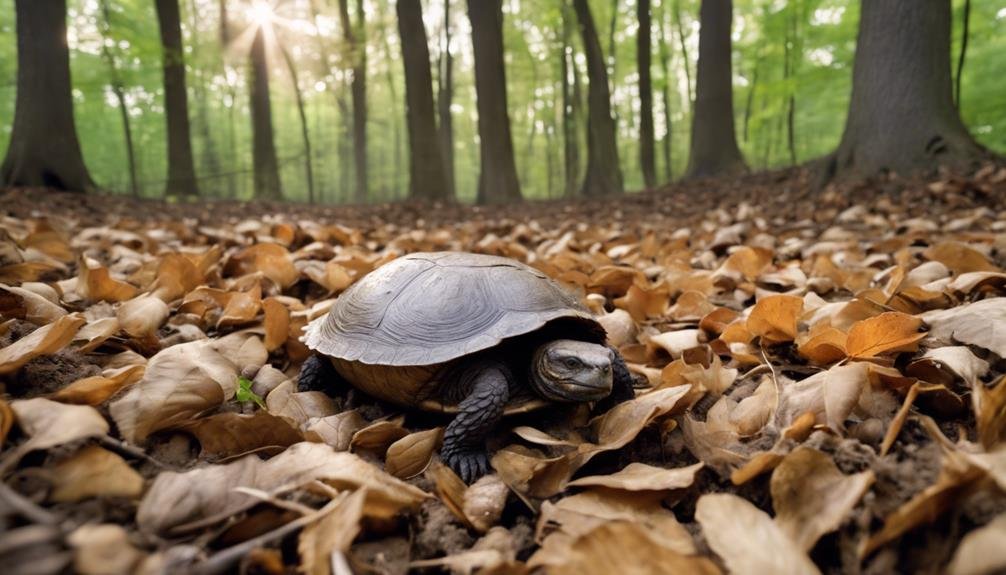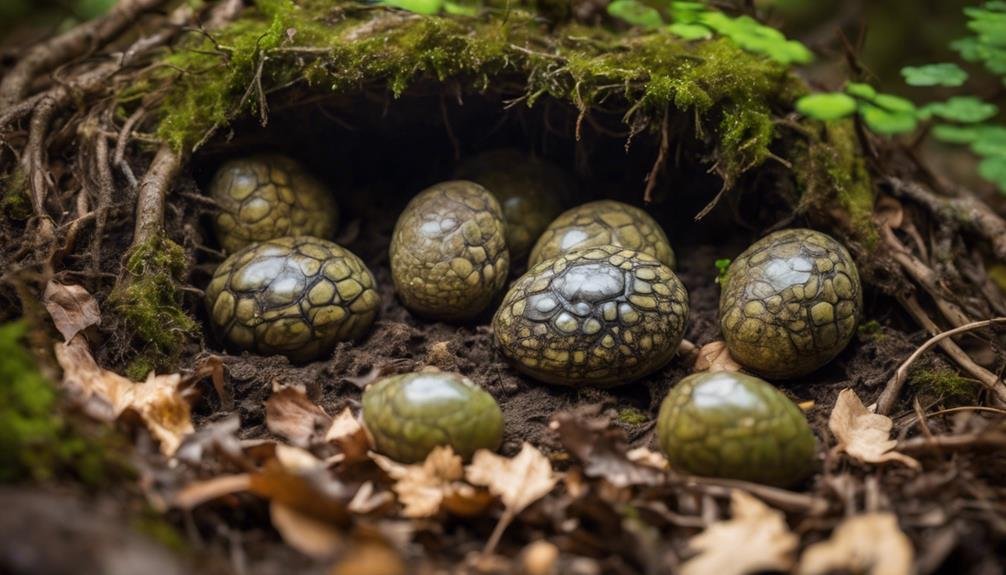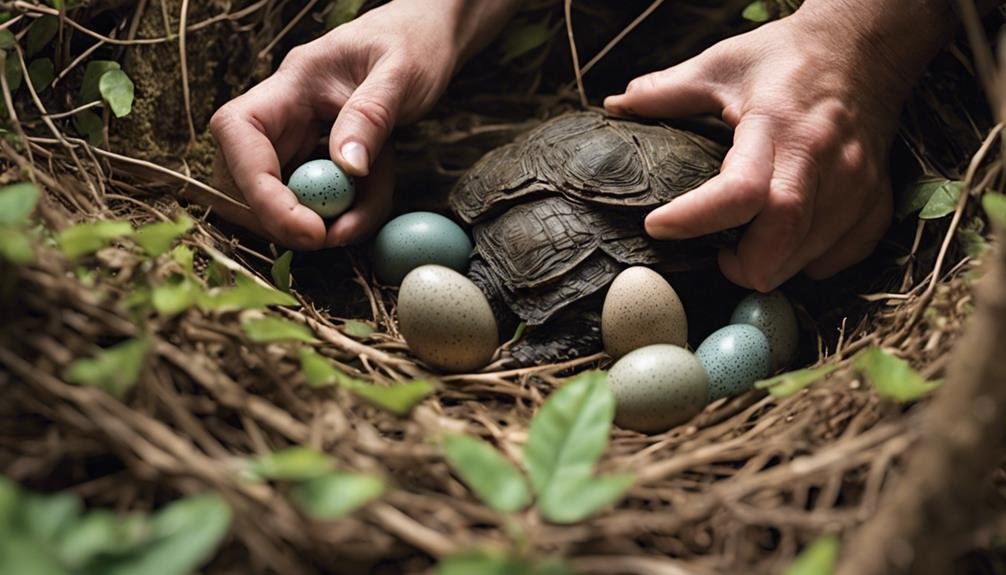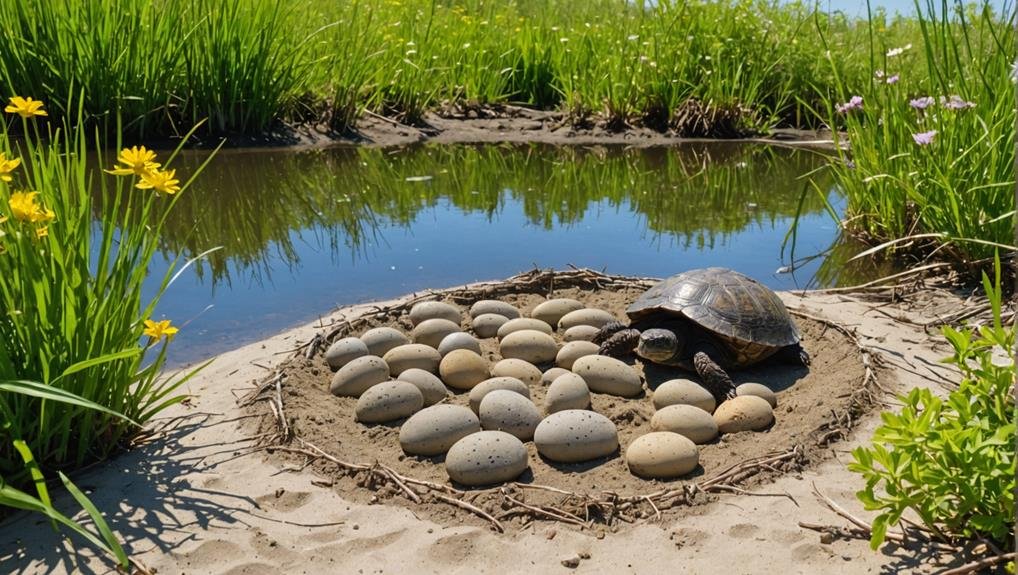When snapping turtle eggs, you look at a fascinating intersection of nature’s intricacies and survival challenges. Female snapping turtles make the arduous journey to find the perfect nesting site, often near water sources, and lay anywhere from 25 to 80 eggs. Though meticulously covered, these nests are not immune to the threats of predators like raccoons and skunks. The incubation period, influenced heavily by temperature, can determine the gender of the hatchlings, adding another layer of complexity. But what exactly makes these eggs vital to conservation efforts, and how do human activities impact their survival?
Key Takeaways
- Snapping turtles lay 25-80 eggs in nests dug 4-7 inches deep in soft soil near water sources.
- The incubation period for snapping turtle eggs ranges from 55 to 120 days, influenced by temperature.
- Raccoons, skunks, and opossums are primary predators of snapping turtle eggs.
- Warmer incubation temperatures produce female hatchlings, while cooler temperatures result in males.
- Conservation efforts include monitoring nests and using barriers to protect eggs from predators.
Nesting Habits


During June and July, snapping turtles exhibit fascinating nesting habits. Female snapping turtles leave their aquatic homes and seek soft soil near a water source. They dig nests typically 4-7 inches deep using their hind legs. This is where they’ll lay their turtle eggs, ensuring the next generation has a chance to thrive.
After digging the nest, the female turtle deposits 25-80 eggs into the hole. The environmental conditions need to be just right for the eggs to develop properly. Once the eggs are laid, the turtle covers the nest with soil using her hind legs, camouflaging it from potential threats. She then returns to the water, leaving the eggs to incubate independently.
The incubation period lasts between 9 and 18 weeks, depending on the environmental conditions. Once the eggs hatch, the young turtles instinctively head towards the water source. This journey is vital for their survival and marks the start of their life in a new habitat.
It’s important not to disrupt this natural process, as it plays an essential role in maintaining the snapping turtle population.
Predation Risks
One of the greatest challenges snapping turtle eggs faces is predation. Predators like raccoons, skunks, and opossums can easily locate and dig up snapping turtle nests, consuming the vulnerable turtle eggs. This greatly impacts the survival rate of both the eggs and the hatchlings. As the hatchlings emerge from the nest, they’re also at risk, trying to reach water while avoiding numerous predators.
To help you understand better, here’s a quick look at the predation risks:
- Raccoons: These clever animals have a sharp sense of smell and can easily detect and unearth nests.
- Skunks: Skunks are infamous for raiding nests and consuming eggs.
- Opossums: These nighttime creatures are skilled at finding and eating snapping turtle eggs.
- Birds and other small mammals: Once the hatchlings emerge, they become easy targets for various predators.
Protecting the nests and ensuring the successful hatching of snapping turtle eggs is vital. Without proper nest protection, these turtle eggs’ chances to survive are significantly reduced.
Incubation Period


Understanding the incubation time of snapping turtle eggs is important for anyone interested in their conservation. The incubation time ranges from approximately 55 to 120 days. During this period, the temperature within the nesting sites plays a vital role in the development and gender determination of the hatchlings. Warmer temperatures typically produce female hatchlings, while cooler temperatures result in males. This temperature-dependent gender determination adds an extra layer of complexity to their development.
Female snapping turtles lay clutches of 10 to 100 eggs in upland nesting sites, which are carefully chosen to provide ideal conditions for the eggs. As the incubation time progresses, the embryos inside the turtle eggs undergo crucial development stages influenced by the ambient temperature. The right temperature ensures not only proper development but also the balanced gender ratio necessary for the species’ population stability.
Once the incubation time concludes, hatchlings instinctively emerge and reach nearby water sources. Understanding these factors can help effectively manage nesting sites, ensuring the successful hatching and survival of these fascinating creatures. Your awareness and actions can make a significant impact on their conservation.
Conservation Efforts
After the hatchlings reach nearby water sources, attention shifts to the significance of conservation efforts to guarantee their survival. Protecting turtle eggs and nesting sites is essential in ensuring these young turtles have a fighting chance. Conservation efforts focus on several strategies to safeguard these vulnerable creatures.
- Monitoring nesting sites: Organizations and volunteers closely watch nesting sites to detect any threats early.
- Implementing protective measures: These include installing barriers to prevent predators from accessing the nests.
- Educating the public: Raising awareness about the significance of snapping turtle conservation helps reduce human interference.
- Minimizing disturbances: Ensuring that nesting sites remain undisturbed by human activity helps protect the eggs and hatchlings.
Human Interaction


It’s crucial to remain calm and well-informed when encountering snapping turtles during their nesting process. Snapping turtles prefer to retreat to the pond when encountering humans, so there’s no need to panic if you spot one laying eggs in your yard. Despite their imposing appearance, these turtles are generally not aggressive unless provoked.
Human interaction can unintentionally disrupt the nesting process, so it’s important to observe from a distance. Children and pets aren’t at risk from nesting snapping turtles, as these animals focus more on the task and return to the water.
Any attempts to move a nesting turtle should be made with great care, as interfering can negatively impact the eggs’ survival.
If you encounter a snapping turtle amid its nesting process, your best course of action is to allow it to continue undisturbed. Observe safely, ensuring that neither you nor the turtle feels threatened. By respecting their natural behavior, you help guarantee that these extraordinary creatures can successfully lay their eggs and contribute to the broader ecosystem.
Conclusion
You’ve learned that snapping turtle eggs face many challenges, from predation to temperature-dependent gender determination. By understanding their nesting habits and the critical incubation period, you can better appreciate the importance of conservation efforts. Protecting nesting sites and minimizing human interference is key to ensuring these vulnerable eggs have a chance to hatch successfully. Your awareness and actions can make a significant difference in the survival of these remarkable creatures.
FAQs
1. How Long Does It Take for a Snapping Turtle Egg to Hatch?
The incubation period lasts 55 to 120 days. Nesting behavior and temperature influence play vital roles. Egg viability is important, and predation risks can delay the hatching process.
2. What to Do if a Snapping Turtle Lays Eggs in Your Yard?
Don’t disturb the nest if a turtle lays eggs in your yard. For wildlife protection, cover it with a crate. DIY nesting sites help with egg incubation. Consider nest relocation for habitat conservation, minimizing environmental impact.
3. What Happens After a Snapping Turtle Lays Eggs?
After a turtle lays eggs, its nesting behavior includes covering the nest and leaving. During the incubation period, focus on nest protection. Hatchling care begins as they head to the water, facing predation risks and relying on habitat preferences.
4. Should I Destroy Snapping Turtle Eggs?
No, you shouldn’t destroy the eggs. Consider conservation concerns and the environmental impact. Legal implications and ethical considerations demand habitat protection and effective wildlife management. Contact local authorities for guidance on how to handle them properly.

